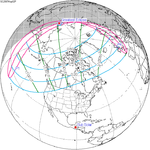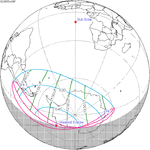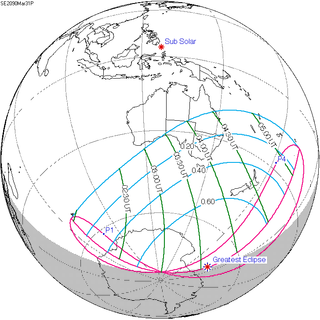Solar eclipse of March 31, 2090
Appearance
| Solar eclipse of March 31, 2090 | |
|---|---|
| Type of eclipse | |
| Nature | Partial |
| Gamma | −1.1028 |
| Magnitude | 0.7843 |
| Maximum eclipse | |
| Coordinates | 72°06′S 156°18′W / 72.1°S 156.3°W |
| Times (UTC) | |
| Greatest eclipse | 3:38:08 |
| References | |
| Saros | 150 (21 of 71) |
| Catalog # (SE5000) | 9710 |
A partial solar eclipse will occur on March 31, 2090. A solar eclipse occurs when the Moon passes between Earth and the Sun, thereby totally or partly obscuring the image of the Sun for a viewer on Earth. A partial solar eclipse occurs in the polar regions of the Earth when the center of the Moon's shadow misses the Earth.
Related eclipses
Solar eclipses 2087-2090
This eclipse is a member of a semester series. An eclipse in a semester series of solar eclipses repeats approximately every 177 days and 4 hours (a semester) at alternating nodes of the Moon's orbit.[1]
The partial solar eclipse on June 1, 2087 occurs in the previous lunar year eclipse set.
| Solar eclipse series sets from 2087 to 2090 | ||||||
|---|---|---|---|---|---|---|
| Descending node | Ascending node | |||||
| Saros | Map | Gamma | Saros | Map | Gamma | |
| 120 | May 2, 2087 Partial |
1.1139 | 125 | October 26, 2087 Partial |
−1.2882 | |
| 130 | April 21, 2088 Total |
0.4135 | 135 | October 14, 2088 Annular |
−0.5349 | |
| 140 | April 10, 2089 Annular |
−0.3319 | 145 | October 4, 2089 Total |
0.2167 | |
| 150 | March 31, 2090 Partial |
−1.1028 | 155 | September 23, 2090 Total |
0.9157 | |
References
- ^ van Gent, R.H. "Solar- and Lunar-Eclipse Predictions from Antiquity to the Present". A Catalogue of Eclipse Cycles. Utrecht University. Retrieved 6 October 2018.
Wikimedia Commons has media related to Solar eclipse of 2090 March 31.
External links
- Earth visibility chart and eclipse statistics Eclipse Predictions by Fred Espenak, NASA/GSFC




